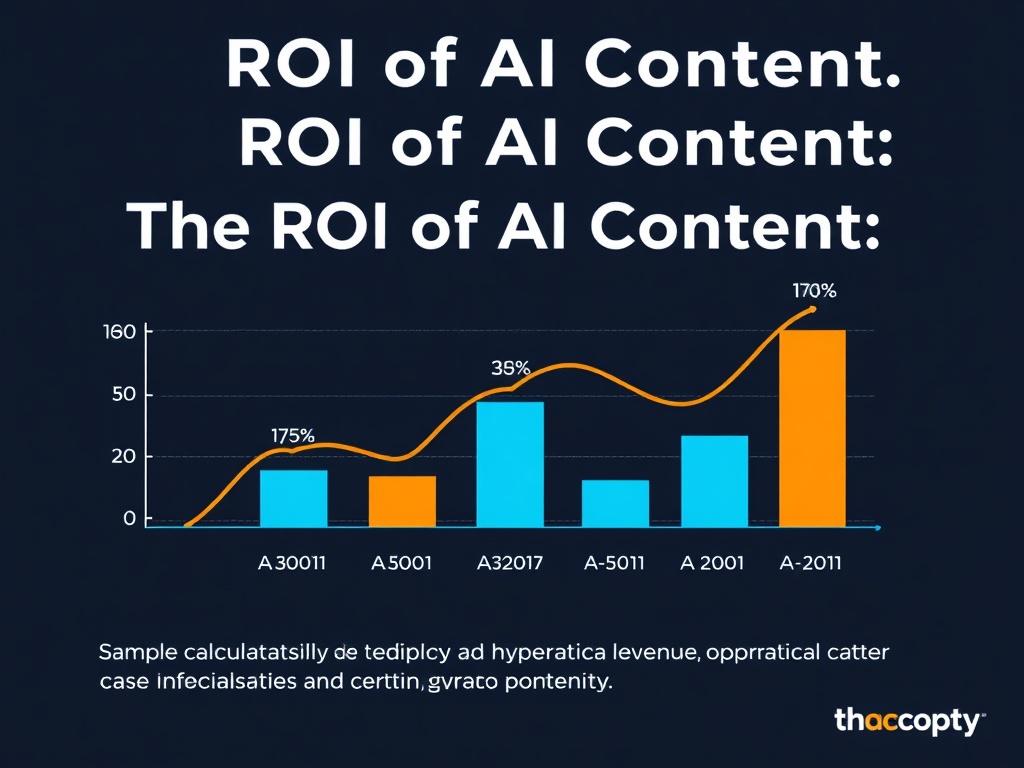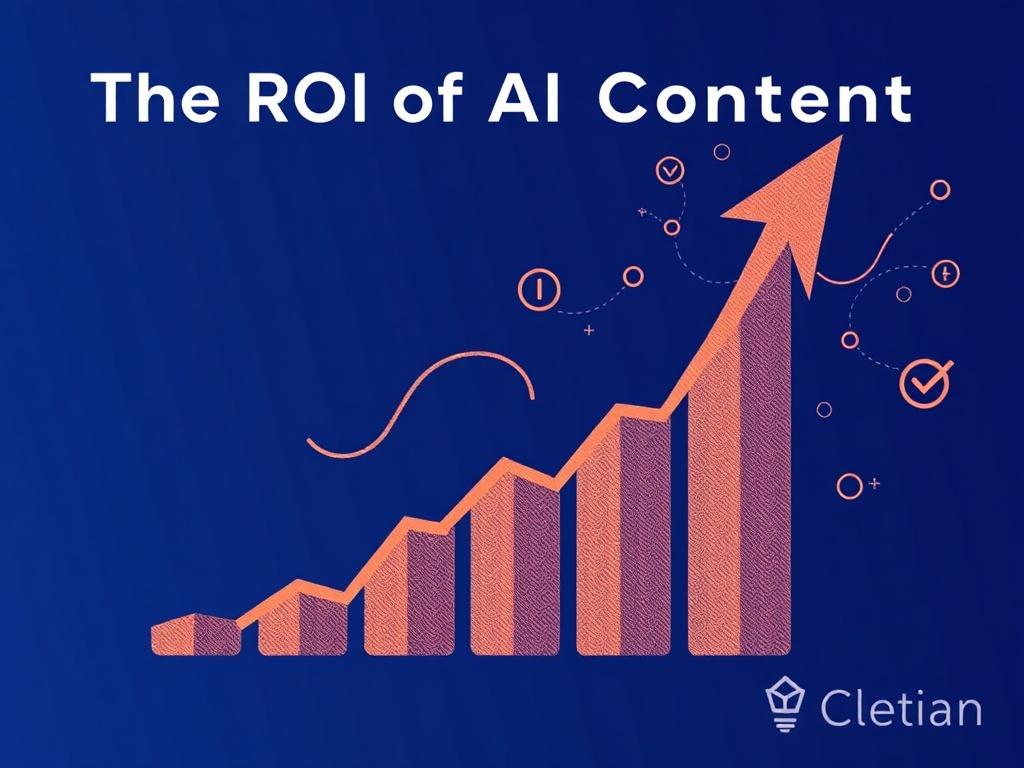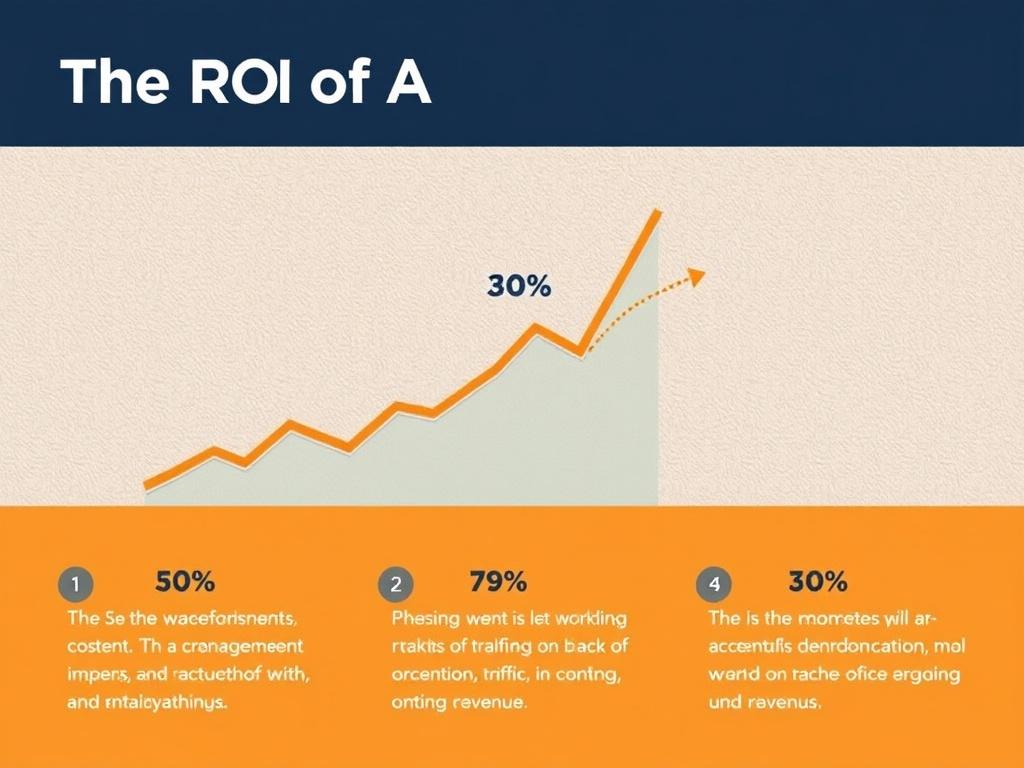Artificial intelligence has jumped from the realm of sci-fi to the core of modern marketing. If you publish content—blog posts, product descriptions, social media captions, or email campaigns—you’ve almost certainly encountered AI tools promising faster production, smarter optimization, and higher returns. But speed and novelty are not the same as value. The big question every leader and creator wants answered is simple: does AI content actually move the needle on traffic, engagement, and revenue? This article walks you through how to measure the ROI of AI content with practical steps, formulas, tests, and real-world thinking so you can make decisions that increase profits rather than just page counts.
Let’s be clear up front: measuring ROI for AI content isn’t a single metric exercise. It’s a blended view that ties outputs (how much content you produce and how quickly) to outcomes (visitors, engagement, leads, purchases) and to economics (costs and revenue). I’ll guide you through which metrics matter, how to set up experiments, how to calculate ROI in ways your finance team will respect, and how to avoid common traps that inflate perceived value. Expect real examples, a helpful table that compares approaches, and checklists you can copy into your next content planning session.
Why measuring ROI for AI content matters
AI content tools can create volumes of copy quickly, but volume alone is a poor proxy for value. Many organizations jump into AI-driven production and assume traffic and revenue will scale linearly. They can’t. Without measurement, you risk amplifying noise: more content that doesn’t rank, doesn’t convert, or damages brand trust. Conversely, measured AI deployment can free up human writers for strategy and creativity, accelerate testing, personalize at scale, and reduce costs.
Measuring ROI creates clarity. It tells you where AI helps, where it hurts, and how to adjust processes so the combination of human and machine work together. When you tie content performance to business outcomes, you get buy-in from stakeholders and the budget to expand what works. Here’s the practical truth: teams that measure see better results faster. They learn which prompts, templates, and editorial checks drive the best outcomes for their audience and bottom line.
Core metrics to track
AI content affects different parts of the funnel. Below are core metrics to track by funnel stage. Track them consistently and tie them into your analytics system so you can attribute impact.
Top-of-funnel (Traffic)
— Organic sessions: visits coming from search engines. This is the primary traffic metric for SEO-driven content.
— Impressions: number of times your content appeared in search results or social feeds.
— Click-through rate (CTR): impressions to clicks ratio in search or email.
— Keyword rankings: positions for target keywords over time.
Middle-of-funnel (Engagement)
— Average time on page: how long visitors engage with content.
— Bounce rate or engagement rate: whether users interact or leave quickly.
— Pages per session: depth of visit.
— Social engagement: likes, shares, comments—especially for topical or brand content.
Bottom-of-funnel (Conversion & Revenue)
— Conversion rate: percentage of visitors who take a desired action (sign up, request demo, purchase).
— Lead volume and lead quality: how many marketing-qualified leads (MQLs) and how they progress.
— Average order value (AOV) and purchase frequency.
— Customer lifetime value (CLV): long-term revenue per customer acquired via content.
— Revenue attributed to content: direct purchases or sales influenced by content.
Operational & cost metrics
— Cost per piece: total spend (tooling, editing, prompts) divided by number of pieces.
— Time to publish: hours from brief to live.
— Human hours saved: reduction in editorial or production time.
— Error rate or revision rate: how often AI output required extensive editing.
How to set up an experiment to measure AI content ROI
If you want credible numbers, run experiments. Follow a clean approach: define objectives, choose a hypothesis, set a timeline, measure baseline, apply AI in a controlled way, and compare results.
Step 1: Define objectives and success metrics
Start by asking: what do you want from AI content? Lower cost per article, higher traffic to a product page, better conversion on a landing page, or faster volume for seasonal campaigns? Your objective determines which metrics you prioritize. For example:
— Objective: Increase organic traffic by 20% in 6 months. Primary metric = organic sessions.
— Objective: Reduce content production cost by 50%. Primary metrics = cost per piece, human hours saved.
Step 2: Establish a baseline
You can’t know improvement without a baseline. Audit recent comparable content: average sessions per article, avg conversions, time to publish, and editing hours. Gather 3–6 months of historical data so seasonality won’t skew the results.
Step 3: Create a controlled test
Don’t replace everything at once. Run A/B tests:
— A/B content on the same URL (if CMS supports it) where variant A is human-written and variant B is AI-assisted.
— Or launch similar pieces on matched topics and compare performance after an identical time window.
Randomize where possible. Control for promotion: ensure both versions get the same social shares, email mentions, and backlink opportunities.
Step 4: Decide on attribution windows
Content ROI can show up immediately (email click to purchase) or over months (SEO traffic). Use multiple windows: 30-day, 90-day, and 12-month views. For SEO-driven content, the 90-day or 6-month window is often more realistic.
Step 5: Track and analyze
Use analytics tools (Google Analytics/GA4, Search Console, CRM, attribution tools) to track the chosen metrics. Build a simple dashboard that reports sessions, conversions, revenue, and cost by content piece. Use UTMs to track campaign links and UTM parameters to resolve paid or distributed content.
Step 6: Calculate ROI
There are several useful formulas. The simplest ROI = (Gain — Cost) / Cost. For content, we often define Gain as revenue attributed to content. For example:
— Revenue from leads generated by content in the testing window = $40,000.
— Cost of AI tools + human editing + distribution = $10,000.
— ROI = ($40,000 — $10,000) / $10,000 = 3.0 or 300% ROI.
But you should also calculate per-piece economics (cost per published piece, revenue per piece) and longer-term lifetime value impact if content affects retention.
Sample calculations and a hypothetical case

Here’s a step-by-step example to make the math concrete.
Scenario
A mid-market ecommerce brand runs a test with two landing pages targeting the same product category. Page A is written by the internal content team. Page B is AI-assisted and edited by the same team. Both pages are launched and promoted identically.
Inputs
| Metric | Page A (Human) | Page B (AI-assisted) |
|---|---|---|
| Organic sessions (90 days) | 6,000 | 8,000 |
| Conversion rate | 2.0% | 2.3% |
| Average order value | $75 | $75 |
| Revenue (90 days) | $9,000 | $13,800 |
| Production cost (human hours valued) | $1,200 | $600 |
| AI tool subscription and prompts | $0 | $200 |
| Total cost | $1,200 | $800 |
Calculations
— Incremental revenue = $13,800 — $9,000 = $4,800.
— Incremental cost = $800 — $1,200 = -$400 (meaning cost decreased by $400).
— ROI on investment = (Incremental revenue — Incremental cost) / Incremental cost? That formula breaks when incremental cost is negative. Instead compute comparative ROI:
— ROI Page A = ($9,000 — $1,200) / $1,200 = 6.5 or 650%
— ROI Page B = ($13,800 — $800) / $800 = 16.25 or 1625%
— Or compute revenue per dollar spent:
— Page A: $9,000 / $1,200 = $7.50 revenue per $1 spent.
— Page B: $13,800 / $800 = $17.25 revenue per $1 spent.
The AI-assisted page produced higher traffic, slightly higher conversions, and dramatically better returns per dollar spent. This is the kind of business-friendly story you can show leadership: better results at lower cost with controlled testing.
Qualitative impacts that matter but are harder to measure
Not all benefits are captured in short-term revenue. Consider these qualitative effects and ways to estimate their value:
Faster experimentation
AI helps publishers iterate quickly: generating variations of headlines, meta descriptions, or landing copy. Faster tests can accelerate learning and compound gains over time. Estimate value by measuring how many tests you can run per month and the expected lift per test.
Improved personalization
AI can generate personalized snippets at scale—email subject lines, product recommendations in copy—leading to higher conversion for the same traffic. Use uplift tests to measure personalization performance.
Better SEO coverage
AI enables topic clustering and long-tail coverage, which often increases organic site authority. Attribution is complicated, but you can measure sitewide organic growth vs. control groups or vs. historical pace.
Reduced burnout and faster time-to-market
Reduced time to publish improves team capacity and helps capture timely opportunities (seasonal offers, newsjacking). You can convert saved hours into economic terms by applying a loaded hourly rate to time saved.
Practical process: Human + AI editorial workflow
AI works best when integrated into a workflow that includes humans at key checkpoints. Here’s a sample process used by effective teams.
- Research & Briefing: Humans define topic, target keywords, persona, and business goal.
- AI Drafting: Use AI to produce a first draft, outline, or multiple headline variants.
- Human Editing: Editors fact-check, add brand voice, optimize for SEO, and refine calls to action.
- SEO & UX Optimization: Apply on-page SEO, internal linking, schema, and UX checks.
- Testing & Measurement: Publish, promote equally, and track performance per the experiment plan.
- Iterate: Adjust content based on analytics and repeat.
This hybrid approach combines AI speed with human judgment and preserves quality while increasing throughput.
Tools and analytics to help measure ROI
Use the right tools to make measurement repeatable and transparent. Build a lightweight analytics stack geared to content ROI.
Suggested analytics stack
| Function | Tool examples | What to track |
|---|---|---|
| Traffic & Behavior | Google Analytics (GA4), Matomo | Sessions, pages/session, time on page |
| Search Performance | Google Search Console, Ahrefs, SEMrush | Impressions, clicks, keyword rankings |
| Conversion & Revenue | CRM (HubSpot, Salesforce), Ecommerce platform | Leads, revenue, conversion rate |
| Attribution | Google Analytics attribution models, third-party attribution | Channel influence, multi-touch attribution |
| Content Management & Tracking | CMS with UTMs or Contentful, Airtable | Content metadata, production cost, owner |
| AI Tools | Copilot tools, writing assistants, summarizers | Tokens used, time saved, version history |
Common pitfalls and how to avoid them
Deploying AI without guardrails can create subtle and not-so-subtle problems. Here are common pitfalls and practical fixes.
Pitfall: Confusing volume with value
AI makes it tempting to pump out content. More articles don’t guarantee more revenue. Fix: prioritize high-impact topics and use AI for repurposing and scaling proven winners, not for random topics.
Pitfall: Skipping quality checks
AI can hallucinate facts or produce inconsistent tone. Fix: mandatory human editorial pass and an SME (subject-matter expert) review for technical content.
Pitfall: Poor attribution
If you don’t tag and track properly, you’ll misattribute lifts. Fix: use UTMs, consistent content IDs, and compare against a baseline with similar promotion.
Pitfall: Ignoring brand voice
Brand tone matters. AI output that sounds off can damage trust. Fix: build style guides and train prompts/templates to match voice. Always have humans polish the tone.
Pitfall: Neglecting SEO fundamentals
AI content alone won’t win if you ignore on-page SEO, internal linking, or site speed. Fix: integrate SEO tasks into the workflow and use AI to optimize metadata, not to skip technical work.
Optimizing for long-term ROI

Sustainable ROI comes from systems, not one-off boosts. Here are actions you can take to lock in gains.
Design for reuse
Create content components that can be reused and automated: intro paragraphs, product descriptions variations, FAQ answers. Reuse reduces marginal cost per unit of content.
Focus on compounding content
Pillar pages, evergreen guides, and hub-and-spoke models compound over time. Use AI to research gaps and generate outlines for these high-value pieces.
Invest in analytics and tagging
Spend time tagging content by theme, funnel stage, campaign, and owner. That metadata makes it possible to pull meaningful ROI reports.
Train your AI prompts and templates
Treat prompt engineering like a product: iterate, test, document. Small improvements in prompts can substantially reduce editing time and increase conversion-ready output.
Measure and improve model bias and risk
Monitor for factual errors, bias, and brand safety issues. Establish an escalation process for questionable content and maintain a human-in-the-loop process for sensitive topics.
When AI content is a poor fit
AI is powerful but not always the right solution. Consider avoiding or limiting AI use in these cases:
- Highly technical or regulated content where accuracy is mission-critical (medical, legal, financial advice).
- Brand-defining content like mission statements, CEO letters, or legal disclaimers.
- Long-form thought leadership that requires deep original insight and reputation building.
- Situations where authenticity and personal storytelling are the primary value drivers.
In these cases, AI can assist with research, summarization, or formatting, but humans should produce the final content.
How finance teams like to see ROI presented
If you want buy-in, present results in a format finance or executive teams prefer: clear dollars, timelines, and scenarios. Use these elements:
Itemize costs
— Tooling subscriptions (monthly/annual)
— Human editorial time (FTE cost or contractor cost)
— Distribution and promotion spend
— Training and implementation cost
Itemize gains
— Direct revenue from tracked purchases
— Estimated revenue from leads (apply conversion probabilities and deal sizes)
— Time savings converted to labor savings
— Estimated future revenue via compounding content (discounted by probability)
Scenario analysis
Show best-case, expected, and worst-case scenarios over 12 months. This captures uncertainty and helps make investment decisions. Finance teams appreciate conservative probability-weighted numbers.
Future trends that will affect ROI
AI content tools will evolve, and the ROI equation will shift. Here are trends to watch:
Better fine-tuning and domain-specific models
Smaller, industry-specific models will reduce hallucinations and improve immediate accuracy, lowering editing costs and increasing trust.
Better analytics integration
Expect tighter integrations between AI content platforms and analytics tools, enabling real-time feedback loops that optimize content for revenue, not vanity metrics.
Regulatory clarity
As regulations around AI transparency and IP evolve, the cost of compliance may change economics. Be ready to adapt your processes.
Human creativity remains scarce
The premium on original ideas and brand voice will grow. Teams that blend AI efficiency with human creativity will capture disproportionate value.
Checklist: Steps to measure and improve AI content ROI
- Define clear business goals for AI content (traffic, leads, revenue).
- Establish baseline metrics and historical performance.
- Run controlled A/B or matched-topic tests.
- Tag content and use UTMs for precise attribution.
- Calculate cost per piece, revenue per piece, and ROI per channel.
- Document prompt templates and editorial workflows.
- Require human reviews for facts, brand voice, and compliance.
- Build dashboards to track 30/90/365-day windows.
- Iterate on prompts and reuse high-performing templates.
- Scale where you see positive ROI, pause where you don’t.
Real-world examples (brief summaries)

Example 1: SaaS company increases trial signups
A SaaS company used AI to generate landing page variants for a new integration. They ran an A/B test and found AI-assisted variants increased trial signups by 18% with 40% less copywriting time. By tying trials to average conversion-to-paid and CLV, they calculated a 6x return on the AI investment in 6 months.
Example 2: Ecommerce scales product descriptions
An ecommerce brand used AI to automatically generate product descriptions and FAQ sections for thousands of SKUs. Conversion rates on product pages rose modestly, but the reduction in time-to-market and improved long-tail SEO produced a compound revenue increase that covered tooling costs within 4 months.
Example 3: Publisher experiments with headlines
A media site used AI to propose headline variants and subject lines, running multivariate tests. Open rates and CTR increased 12%, improving ad revenue and subscription signups. The operation scaled with minimal editorial overhead.
Final practical tips
— Start small and measure early. Don’t replace your entire content pipeline overnight.
— Use AI where it most efficiently augments human skill: drafting, ideation, and personalization.
— Keep humans on brand, fact-checking, and optimizing for conversion.
— Value time savings. Convert saved hours into financial terms when presenting ROI.
— Use multiple attribution windows to capture both immediate and long-term value.
Conclusion
Measuring the ROI of AI content is not mysterious—it’s a disciplined combination of clear goals, baseline measurements, controlled experiments, and honest accounting of costs and revenue. When done well, AI content can produce faster iteration, lower marginal costs, and measurable lifts in traffic, engagement, and revenue. But it requires human oversight, quality controls, and thoughtful attribution so gains are real and sustainable. Start with small, measurable experiments, iterate on prompts and workflows, and tie every content initiative to a business outcome. Over time, the compounding effect of better topics, faster testing, and scale will shift AI from a novelty to a reliable lever for growth.
